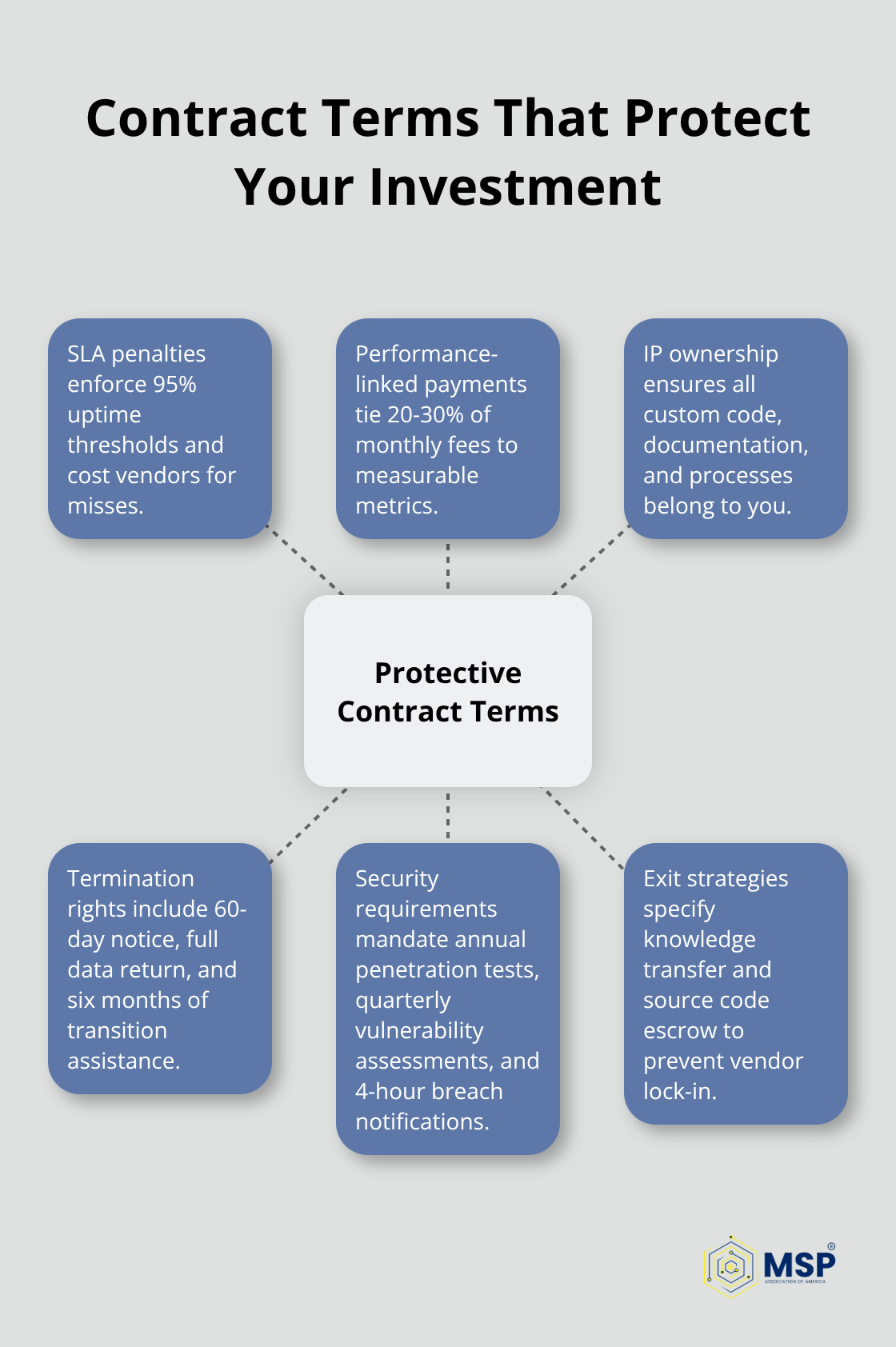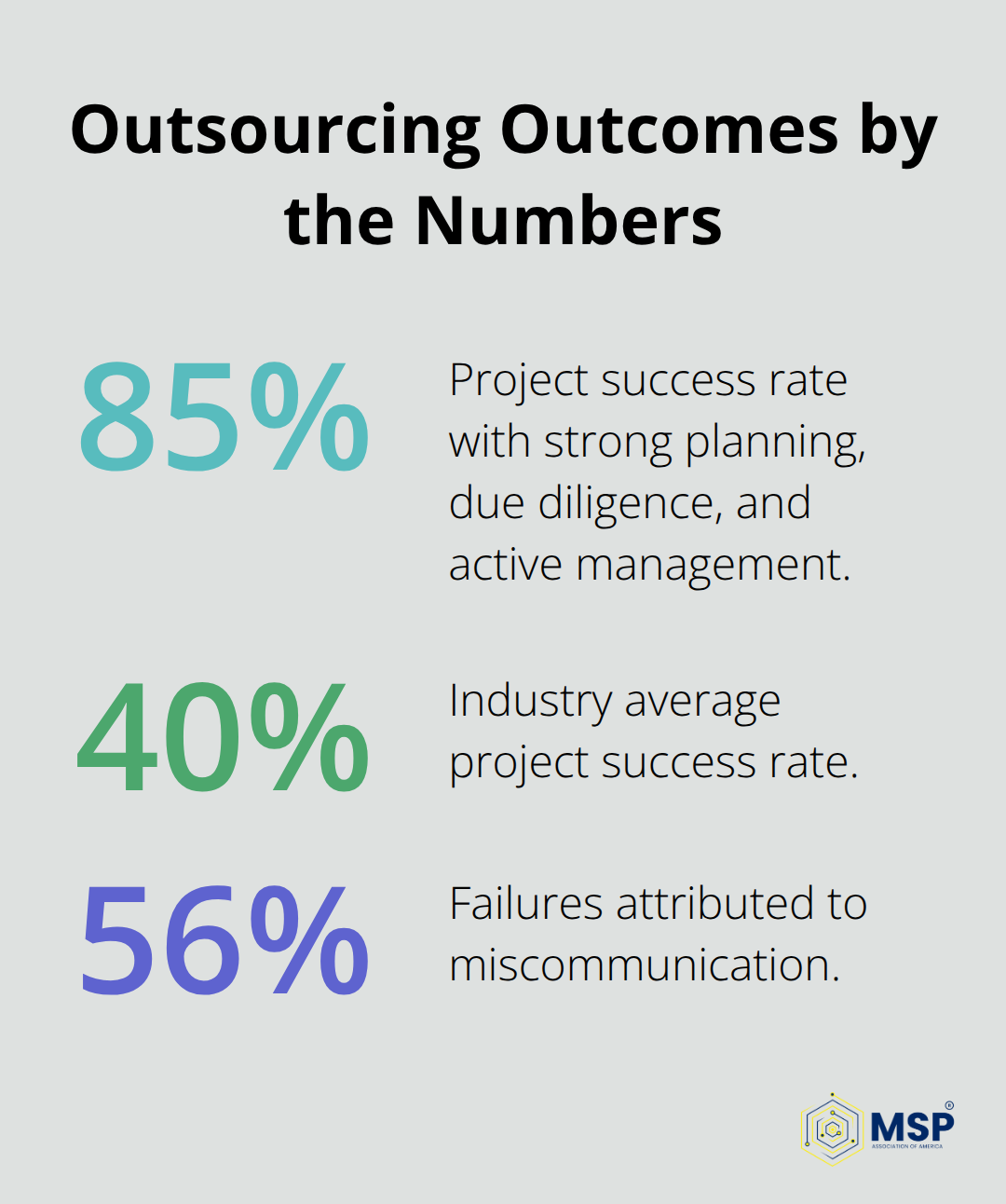The IT Outsourcing Life Cycle: What You Need to Know
IT outsourcing projects fail at alarming rates, with 60% of organizations reporting unmet expectations according to Deloitte’s 2024 Global Outsourcing Survey. The IT outsourcing life cycle spans multiple complex phases that demand careful planning and execution.
What Are the Core Phases of IT Outsourcing
The IT outsourcing life cycle contains four distinct phases that determine project success: strategic planning, vendor selection, implementation, and ongoing management. Each phase requires specific deliverables and timelines that companies often underestimate. Strategic planning takes 8-12 weeks and involves definition of business objectives, internal capability assessments, and creation of detailed requirements documentation.

Organizations that skip thorough planning face 40% higher failure rates according to McKinsey research. The business case must quantify expected cost savings (typically 20-30% for infrastructure services) and identify specific skill gaps that internal teams cannot fill.
Timeline Realities Most Companies Ignore
Vendor selection consumes 12-16 weeks when done properly, which includes RFP development, proposal evaluation, and due diligence. Implementation phases stretch 16-24 weeks for complex projects, with knowledge transfer that requires dedicated resources for 4-6 weeks. Companies consistently underestimate transition time, with only 55% of all product launches happening on time. The ongoing management phase begins immediately after go-live and requires monthly performance reviews, quarterly business reviews, and annual contract evaluations. Each phase demands executive sponsorship and dedicated project management resources.
Critical Success Metrics for Each Phase
Strategic planning success means measurable objectives, approved budgets, and stakeholder alignment before vendor engagement begins. Vendor selection requires scores for at least three qualified providers against technical capabilities, cultural fit, and financial stability. Implementation success depends on achievement of agreed transition milestones without service disruption. Ongoing management effectiveness shows through consistent SLA achievement above 95% and regular cost optimization reviews that deliver an additional 5-10% savings annually.
Common Phase Dependencies That Derail Projects
Each phase builds on the previous one’s outputs, which creates critical dependencies that companies often overlook. Strategic planning must produce clear technical specifications before vendor selection can begin effectively. Vendor selection decisions directly impact implementation complexity and timeline requirements. Implementation quality affects ongoing management costs and relationship dynamics. Poor execution in any single phase cascades through the entire project lifecycle and increases failure probability exponentially.
The success of these foundational phases sets the stage for effective vendor evaluation and selection processes.
How Do You Choose the Right IT Outsourcing Partner
Vendor selection determines outsourcing success more than any other factor, yet many companies struggle with proper evaluation criteria. Technical capability assessments must include hands-on demonstrations of specific technologies your project requires, not generic presentations. Financial stability verification requires three years of audited statements, client references from similar-sized engagements, and proof of professional liability insurance above $5 million.
Cultural alignment testing involves structured interviews with actual team members who will work on your project, not just sales representatives. Geographic proximity matters more than companies realize, with nearshore providers showing better communication than offshore alternatives, as offshore models can add 15–25% in hidden costs through rework and delays caused by communication lags and time zone differences.
Contract Terms That Protect Your Investment
Service Level Agreements need penalty clauses that cost vendors real money when performance drops below 95% uptime thresholds. Payment terms should tie 20-30% of monthly fees to performance metrics, with automatic reductions for missed deadlines or quality failures. Intellectual property clauses must specify that all custom code, documentation, and processes belong to your organization permanently.

Termination rights require 60-day notice periods with complete data return guarantees and transition assistance for six months after contract end. Security requirements must mandate annual penetration testing, quarterly vulnerability assessments, and immediate breach notifications within four hours. Exit strategies need detailed knowledge transfer procedures and source code escrow arrangements to prevent vendor lock-in situations.
Risk Mitigation Strategies That Actually Work
Multi-vendor approaches reduce single points of failure but require dedicated integration management (which adds 15-20% to project costs). Performance bonds from established insurance carriers protect against vendor bankruptcy or project abandonment. Regular third-party audits of vendor security practices and financial health cost $25,000-50,000 annually but prevent catastrophic failures.
Phased implementation with monthly go/no-go decision points allows course correction before problems become disasters. Backup vendor identification during initial selection provides rapid alternatives when primary relationships deteriorate. Communication escalation procedures with C-level contacts at vendor organizations resolve disputes within 48 hours instead of weeks.
Due Diligence Steps Most Companies Skip
Reference checks must include direct conversations with three current clients who have similar project scope and complexity. Site visits to vendor facilities reveal actual team size, infrastructure quality, and operational maturity that proposals often misrepresent. Financial background checks through credit agencies and industry reports expose hidden debt or cash flow problems (that could impact project continuity).
Technical assessments should include code reviews of similar projects, architecture documentation analysis, and security certification verification. Team stability metrics matter more than company size, with turnover rates above 20% annually indicating potential project disruption risks.
Once you select the right partner and finalize contracts, the real work begins with implementation and transition management.
How Do You Execute Flawless Implementation
Implementation failures destroy 70% of IT outsourcing relationships within the first year, which makes transition planning the most critical phase of the entire lifecycle. Knowledge transfer must begin 30 days before go-live with dedicated documentation sessions that capture every process, password, and configuration detail in structured formats. The vendor needs complete access to current systems, network diagrams, and operational procedures through secure virtual data rooms that track all document access for audit purposes.
Transition teams require full-time internal resources for 6-8 weeks, not part-time assignments that delay progress and create knowledge gaps. Shadow periods, where vendor teams observe current operations before they take responsibility, prevent service disruptions that cost companies over $300,000 per hour for mid-size firms. Performance baselines must be established during the first 30 days of vendor operations to measure improvement against historical metrics, not vendor promises.
Performance Monitoring That Drives Results
Weekly performance dashboards with real-time SLA metrics prevent small issues from becoming major failures that require expensive remediation. Automated monitoring tools must send alerts within 15 minutes of threshold breaches, with escalation to vendor management within 60 minutes for critical issues. Monthly business reviews need actual performance data, not vendor-prepared summaries that often hide problems behind favorable statistics.
Relationship management requires dedicated vendor managers who spend 40% of their time on proactive issue identification rather than reactive problem-solving. Quarterly satisfaction surveys with internal stakeholders reveal relationship problems before they impact service delivery. Annual vendor scorecards with weighted metrics for technical performance, cost management, and innovation contributions drive continuous improvement discussions that yield 10-15% additional value annually.
Communication Systems That Prevent Problems
Daily standup calls during the first 90 days keep implementation on track and identify blockers before they cause delays. Project management tools with shared visibility allow both teams to track progress against milestones and deliverables in real-time. Escalation matrices with defined response times and authority levels resolve disputes within 24-48 hours instead of weeks of email exchanges that damage working relationships.
Knowledge Transfer Best Practices
Documentation standards must specify formats, version control, and approval processes that both teams follow consistently. Technical handoffs require live demonstrations where internal staff perform tasks under vendor supervision until competency is verified. Process walkthroughs need recorded sessions that capture decision points, exception handling, and troubleshooting procedures for future reference.
Final Thoughts
The IT outsourcing life cycle demands rigorous execution across every phase to achieve the 20-30% cost savings and operational improvements that drive business value. Companies that invest adequate time in strategic planning, conduct thorough vendor due diligence, and maintain active relationship management see 85% project success rates compared to industry averages of 40%.

The most dangerous pitfall involves rushed vendor selection to meet artificial deadlines, which leads to misaligned partnerships that require expensive corrections later.
Poor communication frameworks create the 56% of failures attributed to miscommunication, while inadequate performance monitoring allows small issues to escalate into service disruptions that cost hundreds of thousands per hour. Long-term partnership success requires companies to treat vendors as strategic allies rather than cost-cutting tools. Monthly performance reviews, quarterly business assessments, and annual contract optimizations maintain alignment and drive continuous improvement throughout the entire IT outsourcing life cycle.
Companies that establish clear escalation procedures and maintain backup vendor relationships protect against single points of failure (which can devastate operations). We at MSP Association of America® connect businesses with qualified managed service providers who understand these lifecycle complexities. Visit our platform to identify MSPs that demonstrate proven track records in successful IT outsourcing implementations and ongoing partnership management.

